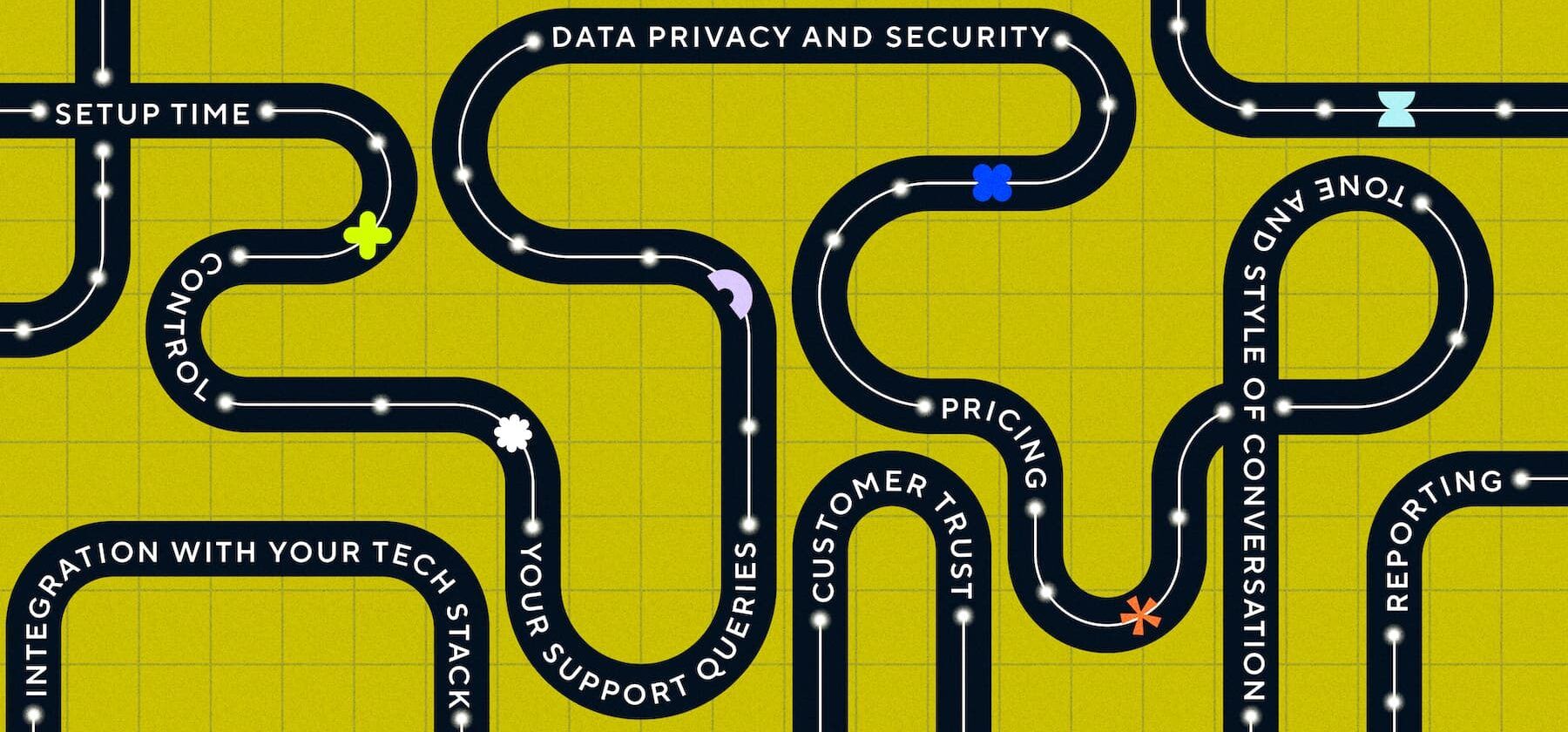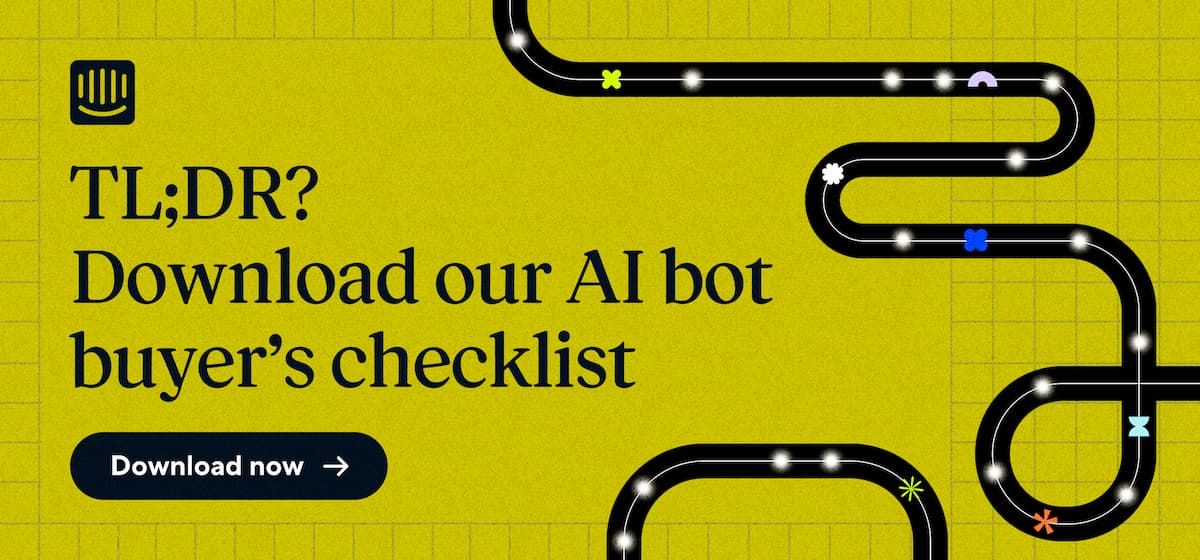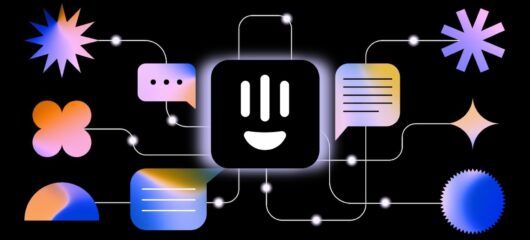
The AI bot buyer’s guide: How to find the right AI chatbot for your support needs
According to our research, 69% of support leaders plan to invest more in AI in the year ahead. But not all bots are created equal, so here’s how to find the AI chatbot that’s right for you.
In our survey of more than 1,000 support leaders and practitioners around the world, the trend was clear: customer service is all set to embrace the benefits of AI, and the teams that act now will see compounding benefits in the years to come. As Intercom’s VP of Customer Support, Declan Ivory, puts it: “The question is no longer ‘Should I use AI or not?’; it’s ‘When and how will I use it?’”
We’ve reached a pivotal moment in customer service, where it’s not just our teams that need to adapt to powerful new technologies, but our customers, too. As well as intrigue and excitement, there’s nervousness, anxiety, and skepticism – so it’s vital that you choose the right software to bring your team, and your customers, along on the AI journey.

Not all AI chatbots are created equal
When you’re dealing with an entirely new form of technology, how do you even begin to find the tool that will offer the best results? It’s a big decision; choosing the wrong AI chatbot could have serious consequences for your customer experience, impacting loyalty and retention for years to come.
We’ve laid out the top things you need to consider when choosing an AI chatbot, as well as useful questions you can ask to find the perfect fit.
- Your support queries
- Setup time
- Data privacy and security
- Tone and style
- Control
- Pricing
- Integration with your tech stack
- Reporting
- Customer trust
1. Your support queries: What kinds of conversations are your support team handling?
Before choosing an AI chatbot, it’s worth reflecting on the different kinds of queries your team encounters every day. Consider the following factors:
Conversation volume
The number of queries you receive will be a major factor in your AI bot choice. You’ll need to compare the bots’ potential resolution rates, pricing models, and how seamlessly they can hand queries off to your support team.
Conversation complexity
If your team receives a large number of repetitive, easily resolved questions, then an AI chatbot is the perfect partner. Many AI bots can quickly handle your FAQs with great success. The real differentiator is how the bot can work with your team, blending the power of human and AI support to create the optimal customer experience. If you’re looking to stay ahead of the curve and exceed rapidly rising customer expectations, you’ll want an AI chatbot that can resolve not just basic questions, but more complex ones – as well as taking actions and triaging the most intricate queries before handing them over to your support team.
Conversation channels
Where do your customer queries come from? If you’re working across more than one channel, as most support teams are, you’ll need to know the bot’s capabilities for handling your queries and ensuring a consistent customer experience across channels. If you’re dealing with a high call and ticket volume, you might need a bot capable of diverting these conversations to chat to reduce the pressure on your team.
A great way to get an idea of whether a bot will works with your queries is to try it out! Some AI chatbots (like Intercom’s Fin) have a “try before you buy” demo option, allowing you to see how they would work with your own support content, and determine what kind of results to expect.
Find out:
- What is your team’s current automated resolution rate, and how much can you expect the AI bot to boost these numbers?
- How does the bot’s answer speed compare to its answer accuracy?
- Can the bot handle queries across the various support channels your customers depend on?
- Is there an option to demo the AI bot before you commit?
2. Setup time: How much time can you spare to set up the bot?
Our 2023 Customer Service Trends Report revealed that 84% of support teams have seen an increase in customer expectations over the past year. Support teams are working harder than ever to keep up, and many don’t have a spare minute, let alone hours, to dedicate to a complex bot setup process.
In a recent report, Senior VP of Global Customer Advocacy at Zendesk Caitlin Keohane said: “Many AI solutions on the market are expensive and take ages to set up, requiring heavy IT spending, lengthy implementation, and specialized resources.” Setup times can range from a few minutes (like Intercom’s Fin) to days, or even weeks, of ground work – so be sure you know what you’re letting yourself in for!
Consider the resources you have on hand to get your AI chatbot up and running: what team members can you spare, and for how long? How much time can you give to team training? If the answer is “not much,” it’s worth prioritizing an AI bot that can hit the ground running. The sooner your bot can assimilate with your team’s processes, the sooner you can start to see real results and return on your investment.
Find out:
- How easy is it to get started with this chatbot?
- Will the AI bot require training before it can begin to bring real value to your team?
- What kind of resolution rate can you expect to see right out of the box, and how will it improve over time?
- Will the AI chatbot require ongoing technical configuration to operate effectively? If so, does your team have the necessary resources to maintain it?
3. Privacy and security: What are your data privacy and security requirements?
Data privacy and security is a priority for every company, but depending on the nature of your business, it may be your number one concern. AI chatbots use large language models (LLMs) to respond to the questions they receive, meaning the information your customers offer will be processed through any of the increasing number of LLMs available, whether it’s GPT-4, Claude, Bard, or any other – and may, or may not, be retained for a period of time.
In order to assure your customers that their data will be safe, it’s important to understand the LLM your chosen AI bot will work with, and how it will handle your data. For instance, Intercom’s agreement with OpenAI includes a “zero retention policy”, so no customer questions or the answers provided by Fin are retained by OpenAI.
Below are some questions you can ask to dive a little deeper into the suitability of an AI bot for your business.
Find out:
- Does the AI bot provider have a partnership with a particular LLM provider?
- How will your customer data be used? Will it be retained by the LLM provider? For example, some LLM providers don’t retain any data, while others will retain data for a specified period of time.
- Is your customer data being used to build or train AI models by your current provider? Are you comfortable with this?
- Will customer messages be encrypted?
- Where is your data hosted, and will the location affect your ability to use the AI bot?
4. Tone and style: How would you like your bot to speak to your customers?
After years of navigating chatbots, your customers feel like they have to use stilted, keyword-focused, and unnatural language to interact with them. In fact, our recent user research revealed that until now, people have found interactions with bots to be frustrating and clunky.
That’s changing rapidly. A year ago, we never would have expected to have an actual conversation with a chatbot, or to ask questions in the way that comes most naturally to us. And yet, that’s exactly what AI has made possible. The most exciting aspect of ChatGPT was its ability to understand and respond to our questions as a human would.
Not only that, but some AI chatbots can disambiguate tricky questions, asking for more details so they can best process and address customer queries. Now you can offer your customers a speedy, friendly response from a bot that can get to the crux of their query, then either answer or pass directly to the relevant person on your support team.
Find out:
- Can the bot disambiguate customer queries?
- Can the bot effectively triage customer queries and route them where they need to go?
- Can you test the bot before you buy to find out how it responds to your most common queries?
5. Control: What level of control would you like to have over your AI chatbot?
As soon as ChatGPT came on the scene, it was clear that it would have major repercussions for the customer service industry. A tool that could draw information from anywhere on the internet in response to a prompt seemed made for customer service. But as time went on, it became clear that “hallucinations” – the phenomenon where an LLM confidently makes up a convincing but false answer to a question – were going to be a challenge.
Luckily, that obstacle is now being overcome. Different AI chatbots will have different approaches to guardrailing the information that’s provided to your customers and ensuring that it:
- Offers trustworthy answers to customer queries.
- Admits when it doesn’t know the answer and passes the query to a human support rep.
- Provides only the information you want it to, e.g. doesn’t start recommending your competitors or going against best practices in your product.
For example, Intercom’s AI bot Fin is controlled by our own sophisticated guardrails, and draws responses only from the help content you choose. If the answer isn’t there, Fin asks clarifying questions, acknowledges that it doesn’t know the answer, and passes the question seamlessly to your support team so that your customers never leave the conversation without the answer they need.
What’s your AI bot’s job description?
Once you’ve ensured the appropriate guardrails are in place, it’s time to think about controlling your AI bot’s scope. What questions do you want the AI bot to answer, what actions do you need it to be able to take, and what would you rather your support team handle? If you’re simply looking for an AI chatbot that addresses FAQs, then this may not be a priority for you – however, if you’d like your bot to handle requests and take action in response, you’ll need to look a little deeper.
For example, Intercom’s AI bot Fin works with our Custom Answers, Custom Actions, and Workflows products to enable you to create bespoke answers to your most important questions, and allow the bot to take actions in response to customer requests.
Find out:
- Where does the AI bot pull information from?
- Are there guardrails in place to prevent hallucinations?
- If the bot can’t answer a question, what does it tell the customer? Can it admit that it doesn’t know?
- Can you control which situations prompt the bot to pass a conversation to a human support rep?
6. Pricing: What model works best for you?
When it comes to AI chatbots, it’s incredibly important to understand the kind of pricing model that will provide the best ROI for your team. AI chatbots are being priced in lots of different ways, but these models essentially boil down to two pricing philosophies.
Pricing against outcomes
These pricing models are based on measurable results that impact your team performance. An example would be pricing against resolutions, which is what we’ve chosen to do at Intercom. This means you only pay when your customer has received a satisfactory answer to their question without having to be passed to your support team; it’s value-based, it’s measurable, and it makes it easy to tell the kind of ROI your AI bot is providing to your team.
Pricing against usage
Examples of this would be pricing based on API requests or messages. It can often be difficult to ascertain ROI when your AI chatbot is priced against these metrics, because they don’t account for customer satisfaction. It’s hard to be sure whether your customer got the answer they needed, or just left the conversation frustrated.
Consider what will ensure the highest ROI for your team by comparing prices against the cost of adding headcount, and against the savings you’ll gain from improving team efficiency and dedicating more time to customer satisfaction and retention.
As Eric Fitzgerald, a Customer Support Manager here at Intercom, put it:

Find out:
- What metric are you using to determine how much your team will pay for the bot?
- How are you defining this metric?
- What is your cost to serve? How does it compare to the price per unit, i.e. per resolution, per message, or per deflection, depending on your chosen bot?
- Based on the LLM you’re using, what level of accuracy can you expect from responses, and how will this affect the ROI of the bot?
7. Integration: How will the AI bot work with your current support platform?
Every support team has carefully planned processes and workflows that are optimized for efficiency and an excellent customer experience. It’s natural to fear that bringing in new technology, like an AI chatbot, could disrupt the way the team operates.
An AI bot should work with, not parallel to, your current setup. Some bots operate as add-ons to whichever platform you’re using, while others are native to their platforms. At this time of massive change, your team may be considering switching platforms to take advantage of more advanced AI technology and truly integrate an AI chatbot into your tech stack. But for those who aren’t quite ready to take that step, some AI bots will work with any support platform.
For example, Intercom’s Fin works with any public URL, so no matter which tool you’re using, it will slot into your support tech stack with ease. However, it’s also natively integrated into Intercom’s unified messaging platform, meaning it will work seamlessly with Intercom’s Messenger, Inbox, automations, and other tools.
Find out:
- How will this bot work with your existing tech stack?
- Do you need to purchase other tools alongside the bot to maximize effectiveness?
- What kinds of integration capabilities will you need to get the most from your AI bot?
- Will the bot allow support reps to summarize conversations and hand off to their teammates?
8. Reporting: What kind of reporting functionality can you expect?
One thing the AI revolution won’t change is the importance of reporting for support teams. When choosing your AI chatbot, consider what kind of reporting you’ll need for the following areas:
Determining the ROI of your AI chatbot
You’ll need a reporting system that offers robust insights into how the bot is affecting your most important metrics.
Identifying areas for improvement
Some AI bots have the capacity to improve as they ingest more of your support material, and as your team strengthens your support content and and optimizes workflows to boost its performance. A solid reporting system should indicate the areas where the bot could be offering more value, so you can maximize its strengths.
Sharing results with the wider company
As every customer service manager knows, pulling these insights is only half the work – the rest is sharing the reports with management and the wider company so everyone can get behind the support team’s efforts and appreciate the value AI is bringing to the customer experience.
Find out:
- What kind of reports are available?
- How will the reporting system work with your current reports?
- Are the reports easy to share? Can they be exported to business-wide reporting tools?
9. Customer trust: How will the AI chatbot help build trust with your customers?
We’ve already touched on the importance of strong guardrails that prevent your AI bot from hallucinating, but how will the bot help your customers to trust it? This is a cultural issue more than an issue with individual AI bots – people have had negative experiences in the past, and now show general preference for human support. Nevertheless, there are ways that your AI chatbot can help you to build trust among your customers.
Be flexible: Give your customers an easy route to get to a human if they want to. If your customers know there’s a human ready to help them, they’ll often be more likely to give the bot a try.
Be accurate: As we’ve already discussed, accuracy has a huge part to play in trust. If customers are receiving high-quality, up-to-date information, they will quickly learn to trust the bot.
Customize: Can the bot be customized to suit your brand? Your customers will feel more comfortable engaging with a bot that’s clearly aligned with your brand.
Language: We’ve discussed language above, but the natural language of generative AI is far more likely to put customers at ease than the keyword-activated bots we’ve been used to until now.
Delivery: How will your messenger make the most of your bot’s power? Even the greatest AI chatbot can’t live up to its full potential if it’s not situated within a world-class messenger.
Find out:
- Is the bot customizable?
- How will the AI bot work within your support messenger?
- Is the bot open about the fact that it’s a bot? How does it deal with questions about itself?
- Is it easy for a conversation to be passed to a human support rep if the customer asks?
These nine considerations will give you the answers you need to choose the perfect AI partner to help you exceed your customers’ expectations and maximize your support team’s skills and expertise. Are you already considering vendors? Use our AI chatbot vendor scorecard to compare them and find the one that best meets your team’s requirements.






